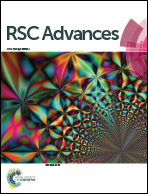Synthesis of highly visible light active TiO2-2-naphthol surface complex and its application in photocatalytic chromium(vi) reduction
Abstract
Photocatalysis is an effective approach for the removal of heavy metal ions present in the aquatic bodies. In this report, TiO2 nanoparticles were successfully functionalized with 2-naphthol (2-NAP) using simple and scalable condensation reaction. The prepared photocatalyst was demonstrated as superior visible light photocatalyst for the effective reduction of Cr(VI). The 2-NAP functionalized TiO2 displayed a remarkable enhancement in the photocatalytic reduction of Cr(VI) under visible light irradiation (λ > 400 nm). The maximum Cr(VI) reduction of about 100% (7 fold higher activity than bare TiO2) was achieved within 3 h. The discernible enhancement in the photocatalytic reduction of TiO2-2-NAP can be ascribed to improved optical absorption in visible region, high crystallinity of TiO2 and high surface area. In addition, the photogenerated electron transfer from 2-NAP to TiO2 (ligand to metal transfer) can significantly improved the photocatalytic performance than bare TiO2 counterparts. Therefore, the functionalization of metal oxides with organic ligands can open new directions to overcome the existing limitations in photocatalysis.


 Please wait while we load your content...
Please wait while we load your content...